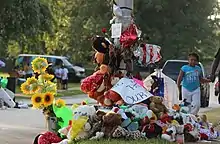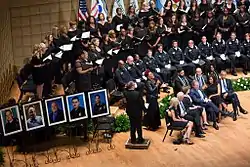Anti-police sentiment
Anti-police sentiment refers to a social group or individual's attitude and stance against police officers. It can involve rhetoric, protests, or abuse.[1]

By country
United Kingdom
Contrary to its European neighbours England did not have a tradition of professional police forces. Crime prevention was carried out by a combination of the town watch and the parish constabulary appointed by the justices of the peace in each county. In Great Britain during the late 1790s, anti-police views were based on the possible encroachment of absolutism through professionalised law enforcement, the obstruction of the magistrates' power and skepticism towards trusting an unfamiliar organisation.[2]
United States
In the 1950s, William Westley suggested that anti-police sentiment may come from the social stigma of working in dangerous conditions, having to work with stigmatized others, and at times unethical practices.[3]
In the 1970s, police departments began to become concerned about litigation over police misconduct.[1]
Distrust of police in the U.S. is sometimes mentioned in connection to police brutality and racial profiling.[4]
.jpg.webp)
In 1991, African American man, Rodney King, was savagely beaten by four Los Angeles Police officers. The following year, the 1992 Los Angeles riots broke out in response to the acquittal of the police officers involved in the beating. This event brought large amounts of media attention to police brutality towards minorities such as African Americans.
The 2014 shooting of unarmed Michael Brown in Ferguson Missouri and the ensuing outrage is considered a turning point in the U.S. dialogue of the "war on cops"[4] with the Black Lives Matter movement challenging the legitimacy of the police.[4]
Minority groups in disadvantaged neighborhoods tend to distrust police more[5] and feel that the "law is not on their side".[6]
The role of police in the restriction of youth freedom has also perpetuated anti-police sentiments among young people.[7]
President Trump has on several occasions condemned the anti-police atmosphere.[8][9][10][11]
Examples

- The shooting of unarmed African American Michael Brown by a police officer in 2014 caused public outrage in the U.S. and a condemnation of law enforcement's use of force against the marginalised.[8] Culhane, Boman and Schweitzer have pinpointed that in the post-Ferguson era, there is a greater preconceived assumption among the public that the police are the perpetrators of unjustified violence rather than the offender being at fault in incidents of police brutality.[8]
- The July 2016 shooting of Philando Castile in Minnesota resulted in a large protest that included vandalism of police headquarters such as covering them with red paint.[12][13]
- The 2016 shooting of Dallas Police officers in Texas killed 5 officers.[14] The shooting was conducted during an anti police-brutality protest.[15]
- The 2017 St Louis Protests were a response to the police shooting of Anthony Lamar Smith in 2011.[15] Banners containing anti-police rhetoric were shown, police cars and other property were damaged.[16] 10 officers were injured during the violent protests.[15]
- The 2019 Jersey City shooting was motivated in part by anti-law enforcement beliefs.[17]
Media
Smartphones, allowing people to capture real-time recordings of confrontations with police and spread them across the internet, have been mentioned in helping extend anti-police sentiment.[10][4] A narrative from mass media and spread through social media may reinforce a "us vs. them" mentality that is detrimental to society's relationship with police.[18]
Anti-police sentiment also manifests in hip-hop and other forms of music such as rock and nu metal.[19]
Examples
- Public Enemy – The late 1980s was a significant time for the hip-hop industry with the release of music that was explicit in its social commentary on the corrupt morality of authorities.[20] As such, anti-police views began to be expressed by hip-hop groups such as Public Enemy who released "Fight the Power" in 1989, holding a harsh mirror to the police force for them to recognise their racial prejudice. Thus, it became an "anthem for the kind of resistance that rap music had already begun to embrace".[20]
- N.W.A – Another notable example of anti-police rhetoric existent in popular culture is N.W.A's song "Fuck tha police" released in 1988 which was inspired by their personal encounters with law enforcement that involved discrimination. The reception of this song by authority figures was utter discontent, causing the proliferation of tensions between the rap group and the police.[21] On the other hand, its reception with the African American community was powerful as it "struck a nerve for many people, especially the marginalized communities. They wanted justice, too, but only in fictional songs like ‘Fuck tha police' could they seem to find it".[21] Its provocative lyrics have influenced other artists such as Mayhem Mal who utilised the same title and received backlash for its anti-police undertones.[21]
- Uncle Marda & Maida – The statements in Uncle Marda & Maida's 2014 song "Hands Up" has been described as "a parable about what happens when a marginalised community simply can't take it anymore".[18] The lyrics were anti-police and the music video depicted power inversion.[18]
- Rage Against the Machine — R.A.T.M's signature 1992 song, Killing in the Name, makes numerous references to police brutality, corruption, and institutional racism throughout the lyrics with the verse "Some of those that work forces, are the same that burn crosses" being the most prominent and, arguably, memorable of the non-hook lines in the song. The verse specifically references the historical and contemporary phenomenon of some law enforcement officers also being members of the Ku Klux Klan and other white supremacist hate groups in the United States. Time and time again, such officers have been exposed and outed by their departments, however, it is still a credible threat to the society as officiated by the FBI in numerous investigations.
U.S. police response
Police have expressed feeling threatened by violent protesters and attackers, and a dissatisfaction with a larger gap between police and the community.[6]
Some have blamed media for fueling anti-police sentiment. Chuck Cantury Howard Safir identified "a war on police" in his letter to President Barack Obama.[4] Former FBI director James Comey addressed in 2015 by positing that "a chill wind [is] blowing through American law enforcement over the last year… and that wind is surely changing behavior".[4] Academics have theorized that "de-policing" may be seen in America as a response to police dissatisfaction in some areas.
References
- Reynolds-Stenson, Heidi (2017-09-22). "Protesting the police: anti-police brutality claims as a predictor of police repression of protest". Social Movement Studies. 17 (1): 48–63. doi:10.1080/14742837.2017.1381592. ISSN 1474-2837. S2CID 149328638.
- Barrie, David G. (2008-10-01). "Patrick Colquhoun, the Scottish Enlightenment and Police Reform in Glasgow in the Late Eighteenth Century1". Crime, Histoire & Sociétés. 12 (2): 59–79. doi:10.4000/chs.359. ISSN 1422-0857.
- Mawby, Rob C.; Zempi, Irene (2018). "Police officers' experiences as victims of hate crime". Policing. 41 (5): 526–538. doi:10.1108/PIJPSM-12-2016-0176. ISSN 1363-951X.
- Maguire, Edward R.; Nix, Justin; Campbell, Bradley A. (2016-09-29). "A War on Cops? The Effects of Ferguson on the Number of U.S. Police Officers Murdered in the Line of Duty". Justice Quarterly. 34 (5): 739–758. doi:10.1080/07418825.2016.1236205. ISSN 0741-8825. S2CID 151627812.
- Sharp, Elaine B.; Johnson, Paul E. (2009). "Accounting for Variation in Distrust of Local Police". Justice Quarterly. 26 (1): 157–182. doi:10.1080/07418820802290496. ISSN 0741-8825. S2CID 143867268.
- Wahl, Rachel (2017). "No Justice, No Peace?: The Police, People of Color, and the Paradox of Protecting Human Rights". Human Rights Quarterly. 39 (4): 811–831. doi:10.1353/hrq.2017.0050. ISSN 1085-794X. S2CID 149148180.
- Lurigio, Arthur; Greenleaf, Richard; Flexon, Jamie (2009). "The Effects of Race on Relationships with the Police: A Survey of African American and Latino Youths in Chicago". Western Criminology Review. 10 (1): 29–41.
- Nix, Justin; Wolfe, Scott E.; Campbell, Bradley A. (2017-07-03). "Command-level Police Officers' Perceptions of the "War on Cops" and De-policing". Justice Quarterly. 35 (1): 33–54. doi:10.1080/07418825.2017.1338743. ISSN 0741-8825. S2CID 149114485.
- Balko, Radley (2017). "Trumps, cops and crime". The Washington Post. Retrieved 1 May 2019.
- DeVylder, Jordan E. (2017). "Donald Trump, the Police, and Mental Health in US Cities". American Journal of Public Health. 107 (7): 1042–1043. doi:10.2105/ajph.2017.303827. ISSN 0090-0036. PMC 5463226. PMID 28590854.
- Trump, Donald J. (2017-08-19). "Looks like many anti-police agitators in Boston. Police are looking tough and smart! Thank you". @realdonaldtrump. Retrieved 2019-05-07.
- Lyons, Jenna (2016-07-08). "About 2,000 rally in Oakland in reaction to police shootings". SFGate. Retrieved 2019-05-07.
- "Oakland: Seven arrests in anti-police protest that shut down I-880". The Mercury News. 2016-07-08. Retrieved 2019-05-07.
- Levin (now), Sam; Jamieson, Amber; Glenza, Jessica; Weaver, Matthew; Phipps (earlier), Claire; Kasperkevic, Jana (2016-07-09). "Dallas police shooting: Micah Johnson was 'lone shooter' – as it happened". The Guardian. ISSN 0261-3077. Retrieved 2019-05-07.
- Dart, Oliver Laughland Tom; Dallas, Jon Swaine in; Washington, David Smith in (2016-07-08). "Dallas shooting suspect stated he wanted to 'kill white officers'". The Guardian. ISSN 0261-3077. Retrieved 2019-05-07.
- Taylor, Alan. "A Weekend of Protest in St. Louis - The Atlantic". www.theatlantic.com. Retrieved 2019-05-07.
- Panico, Rebecca (December 12, 2019). "Jersey City shooters had 'tremendous amount of firepower.' Attack investigated as domestic terror, AG says". NJ Advance Media for NJ.com. Retrieved December 13, 2019.
“We believe the suspects held views that reflected hatred of Jewish people as well as law enforcement,” Attorney General Gurbir Grewal said at a press conference. “The evidence points toward acts of hate. We’re investigating this as a potential act of terrorism fueled by anti-Semitic and anti-law enforcement beliefs."
- Steinberg, Robin G (2015). "Police Power and the Scaring of America: A Personal Journey". Yale Law & Policy Review, Inc. 34 (1): 131–153. JSTOR 43921153.
- Fernandes, Sujatha. (2011). Close to the edge : in search of the global hip hop generation. Verso. ISBN 978-1844677412. OCLC 711052051.
- Nielson, Erik (2011-10-06). "'Here come the cops': Policing the resistance in rap music". International Journal of Cultural Studies. 15 (4): 349–363. doi:10.1177/1367877911419159. ISSN 1367-8779. S2CID 145609151.
- Hosking, Taylor; Zaragoza, Alex (2019-03-07). "Rappers Are Defending Their Right to Anti-Cop Lyrics in the Supreme Court". Vice. Retrieved 2019-05-08.
